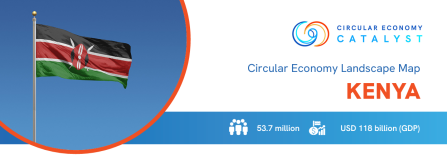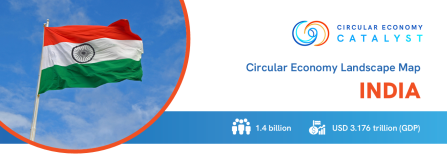Newly released India and Kenya Circular Economy Landscape Maps
| Date |
Date
|
To understand how the Kenyan and Indian circular economy landscapes have evolved over the past year, we conducted a mid-term survey in 2024, targeting Business Development Service (BDS) advisors who work directly with businesses implementing circular practices. These surveys provide invaluable insights into the current state of the circular economy, highlighting changes in opportunities and challenges, emerging trends, and existing gaps within the ecosystem in both countries.
Circular Economy Landscape in Kenya
Kenya‘s progress towards a circular economy has seen significant strides over the past year. As Kenya is projected to almost double its population by 2050 (with the implications of an increase in the demand for more resources and services) and with the current high dependence on climate-sensitive natural resources, the transition to an inclusive circular economy in Kenya is more important than ever.
Small and medium enterprises (SMEs) contribute 35% to Kenya’s GDP, represent 98% of all businesses and employ more than 80% of the working population. Kenya’s economy is highly dependent on natural resources, making the country economically vulnerable to climate change. Opportunities in the circular economy are present along the value chain of enterprises: from optimising inputs, maximising utility of products in the market, designing for increased durability, and retaining value. Each of these opportunities present SMEs with opportunities to tackle challenges faced in their community, as well as to reduce costs and build the resilience of their value chains in response to climate change and market risks.

Access the full Kenya Circular Economy Landscape Map here.
Circular Economy Landscape in India
India’s journey towards a circular economy has also seen notable developments over the past year. As economic growth continues along a linear economic model, India is on the track of an industrialisation path that threatens to exacerbate negative externalities and challenges such as pollution, greenhouse gas emissions, water and food scarcity.
Indian MSMEs are considered the backbone of Indian socio-economic development since they represent 45% of total industrial production, 30.50% of services and 49.5% of India’s total exports, with textiles, garments, different types of shoes, rice and castor oil among the major products exported by the Indian MSME sector. Overall, MSMEs contribute to almost 30% of India‘s GDP.
India’s goals are clear: in 2070, the country will achieve the target of Net-Zero by scaling up its non-fossil energy capacity, reducing carbon emissions and the carbon intensity of its economy. Although India has made progress towards its targets, significant challenges remain, including population growth, rapid urbanisation, food and water scarcity, environmental pollution, infectious diseases, and climate change.

Access the full India Circular Economy Landscape Map here.
